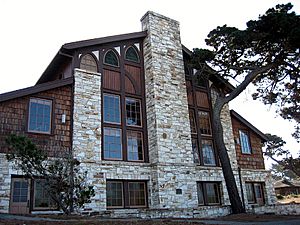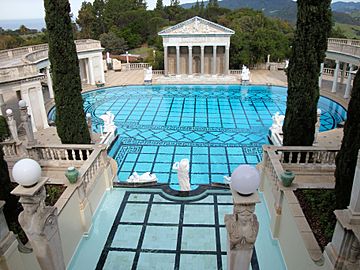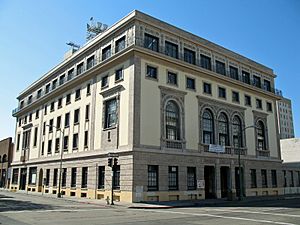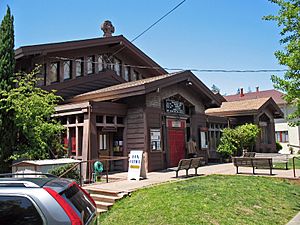Julia Morgan facts for kids
Julia Morgan (January 20, 1872 – February 2, 1957) was a famous American architect and engineer. She designed more than 700 buildings in California during her long career. She is best known for her amazing work on Hearst Castle in San Simeon, California.
Morgan was the first woman allowed into the architecture program at the École nationale supérieure des Beaux-Arts in Paris. She was also the first woman architect to get a license in California. She designed many buildings for groups that helped women and girls. These included several YWCAs and buildings for Mills College.
Julia Morgan was a pioneer in using reinforced concrete in her designs. This material proved to be very strong during earthquakes, like the big ones in 1906 and 1989. She loved the Arts and Crafts movement and used beautiful California pottery to decorate her buildings. She blended classic styles with new ideas, and formal designs with fun touches.
In 2014, Julia Morgan became the first woman to receive the highest award from the American Institute of Architects, the AIA Gold Medal. This award was given to her after her death.
Quick facts for kids
Julia Morgan
|
|
|---|---|

Morgan in 1926
|
|
| Born |
Julia Morgan
January 20, 1872 San Francisco, California, U.S.
|
| Died | February 2, 1957 (aged 85) San Francisco, California, U.S.
|
| Alma mater | University of California, Berkeley |
| Occupation | Architect |
| Awards | AIA Gold Medal |
| Buildings | Los Angeles Examiner Building The YWCA in Chinatown, San Francisco Riverside Art Museum Asilomar Conference Grounds |
| Projects | Hearst Castle |
Contents
Early Life and Education
Julia Morgan was born on January 20, 1872. She was the second of five children. Her mother, Eliza, came from a wealthy family. Her grandfather, Albert O. Parmelee, was a rich cotton trader. He helped support Julia's parents financially.
When Julia was two, her family moved to Oakland, California. Even though they lived on the West Coast, Eliza stayed close with her family in New York. When each child was born, the family traveled to New York for a traditional christening.
Julia's father, Charles Morgan, was a mining engineer. But his business ventures were not very successful. So, the family often relied on the Parmelee family's money. In 1878, Julia's mother took the children to New York for a year. There, Julia met her older cousin Lucy Thornton, who was married to a successful architect named Pierre Le Brun. He encouraged Julia to go to college.
Julia got sick with scarlet fever in New York. This illness caused her to have ear infections later in life. When her grandfather died in 1880, Julia's grandmother moved in with them in Oakland. She brought the Parmelee family's wealth with her. Both Julia's mother and grandmother were strong female role models. They had a lot of influence in the Morgan home because of their money.
Studying Engineering at UC Berkeley
Julia graduated from Oakland High School in 1890. She was very dedicated to her education and wanted to become an architect. She enrolled at the University of California in Berkeley. There was no architecture program, so she studied Engineering.
At the university, Julia was a member of the Kappa Alpha Theta sorority. She was often the only woman in her math, science, and engineering classes. During her time there, women were becoming more involved in campus life. They started clubs and gained access to new activities. Julia helped create a YWCA chapter at Berkeley. This allowed women to use the gymnasium. She graduated in 1894 with honors. She was the first woman to earn a Bachelor of Science degree in civil engineering from Berkeley.
Learning Architecture in Paris
One of Julia's engineering teachers was Bernard Maybeck. He was an architect who designed buildings that fit well with nature. Maybeck became Julia's mentor. He encouraged her to continue her studies at the famous École nationale supérieure des Beaux-Arts in Paris. He had studied there himself.
After graduating in 1894, Julia worked with Maybeck for a year. Then, in 1896, she traveled to Paris to prepare for the Beaux-Arts entrance exam. The school had never allowed a woman to study architecture before. But in 1897, they opened the application process to women. This happened largely because of pressure from a group of French women artists.
It took Julia three tries to get into the school. On her second try in 1898, she scored high enough. But the examiners unfairly lowered her grades. After studying for more than another year, she finally passed the entrance exams. She placed 13th out of 376 applicants! She was admitted to the Architecture Program.
However, she could only study until her 30th birthday. The school did not allow older students. In early 1902, as her birthday approached, Julia submitted an excellent design for a grand theater. This earned her an architecture certificate. She was the first woman to receive one from the school. She finished the program in three years, even though it usually took five.

Career Highlights
After returning from Paris, Julia Morgan worked for San Francisco architect John Galen Howard. He was in charge of the University of California Master Plan. Julia worked on several buildings on the Berkeley campus. She designed decorative parts for the Hearst Memorial Mining Building and an early idea for Sather Gate. She was also the main designer for the Hearst Greek Theatre.
In 1904, Julia Morgan became the first woman to get an architecture license in California. She opened her own office in San Francisco. After her first office was destroyed by the 1906 fire, she opened a new one in 1907. It was on the 13th floor of the Merchants Exchange Building. She worked there for the rest of her career.
Building with Reinforced Concrete
In April 1904, Julia Morgan finished her first building made of reinforced concrete. It was the 72-foot bell tower at Mills College, called El Campanil. Two years later, the big 1906 San Francisco earthquake hit. El Campanil survived without any damage! This helped build Julia's reputation and start her successful career.
The earthquake's damage in San Francisco gave her many chances to design new homes, churches, offices, and schools. She also helped redesign the famous Fairmont Hotel in San Francisco. Its inside was badly damaged by fire after the 1906 earthquake. She was chosen because she knew a lot about building with earthquake-resistant, reinforced concrete. Her work on the Fairmont made her famous across the country. People saw her as a "superb engineer" and an "innovative designer."
Phoebe Hearst was very impressed by Julia's work on the Fairmont. She recommended Julia for several big building projects, including Asilomar. Phoebe's son, William Randolph Hearst, was also very impressed. After his mother died, he hired Julia to design what would become her biggest and most famous project: Hearst Castle.
Designing Hearst Castle and More
Julia Morgan worked with the Hearst family for three generations. Her first project for them was in 1902. It was Phoebe Apperson Hearst's Hacienda at Pleasanton.
Julia's most famous client was William Randolph Hearst. He owned many newspapers and collected old artifacts. He hired Julia in 1919 to design La Cuesta Encantada, which is now known as Hearst Castle. It was built on a hill overlooking San Simeon, California Harbor. Julia used many tiles in her designs, even creating some herself.
Hearst Castle became Julia's largest and most complex project. Hearst's ideas for his estate grew bigger and bigger over the years. The project included The Hacienda, a home and guest house complex. It blended different styles like Mission Revival, Spanish Colonial Revival, and Moorish Revival. Julia worked on 'the Castle' until 1947. She stopped only because Hearst's health was declining.
Julia also designed other buildings for William Randolph Hearst. These included Phoebe Apperson Hearst's Wyntoon estate. This estate has a castle and a "Bavarian village" with four villas. It is located in a large forest near the McCloud River in Northern California.
YWCA Buildings for Women
Julia Morgan's connection with the YWCA started in 1913. Phoebe Apperson Hearst recommended her for the YWCA's Asilomar summer conference center. The Asilomar Conference Grounds are now run by the State. They are still in Pacific Grove, near Monterey, California. Julia also designed YWCAs in California, Utah, Arizona, and Hawaii.
She designed five YWCA buildings in Southern California. The 1918 Harbor Area YWCA in San Pedro is still standing. So is the 1926 Hollywood Studio Club YWCA. Julia's 1929 Riverside YWCA building is now the Riverside Art Museum. Her 1925 Long Beach branch has been torn down. The beautiful Pasadena YWCA is being restored by the city for public use.
She also designed YWCAs in Northern California, including one in Oakland and one in San Francisco's Chinatown. The San Francisco Chinatown YWCA building shows her understanding of traditional Chinese architecture. This building was restored in 2001. It now houses the Chinese Historical Society of America Museum.
Contributions to Mills College
Julia Morgan made many architectural contributions to Mills College. This is a women's college in Oakland, California. Like her work for the YWCA, she did these projects to help create more opportunities for women.
The president of Mills College, Susan Tolman Mills, became interested in Julia in 1904. She wanted to support a female architect. Also, Julia was just starting her career and charged less than male architects. Julia designed six buildings for the Mills campus. This included El Campanil, which is believed to be the first bell tower on a college campus in the United States.
Julia's reputation grew when El Campanil survived the 1906 San Francisco earthquake without damage. This success led to Julia becoming the main architect for Mills College for the next 20 years.
Julia also designed the Margaret Carnegie Library (1906). It was named after Andrew Carnegie's daughter. She also designed the Ming Quong Home for Chinese girls in 1924. This building was later renamed Alderwood Hall. In 2004, it became the Julia Morgan School for Girls. Julia also designed the Mills College Student Union in 1916. Her Kapiolani Cottage has been used as an infirmary, housing for teachers, and administration offices.
Heritage on the Marina
From 1922 to 1925, Julia Morgan designed a home for elderly women in San Francisco. Today, this building is called Heritage on the Marina. It is a community for seniors. The beautiful Julia Morgan building is owned by the San Francisco Ladies’ Protection and Relief Society. This is one of California’s first charity organizations, started in 1853.
Other Notable Projects
One of Julia's earliest works was the North Star House in Grass Valley, California. It was built in 1904-1905.
She considered St. John's Presbyterian Church in Berkeley, California, to be her best Craftsman-style building. It is now the Berkeley Playhouse.
Other projects include the Chapel of the Chimes in Oakland. She also designed the large Berkeley City Club next to the University of California. She designed the World War I YWCA Hostess House in Palo Alto. This building later became the MacArthur Park Restaurant.
Many of her residential projects are called "ultimate bungalows." These homes show the Arts and Crafts movement and the American Craftsman style of architecture. Several of these houses are on Russian Hill in San Francisco. One of her first residential projects was to remodel Phoebe Hearst’s Hacienda del Pozo de Verona in Pleasanton, California.
Personal Life and Legacy
Not much is known about Julia Morgan's personal life. She never married and had no known romantic relationships. She lived a simple life, even though she had many wealthy clients. People who knew her were surprised by her modest style. She gave few interviews and did not write much about herself. She worked very hard, often with little sleep or food.
Julia was very independent. When she moved to Paris, her parents gave her money for her first year. But when her funds ran out, she never asked her family for more. Instead, she learned to live on a small budget. This experience helped her manage money well. It made her a successful businesswoman and helped her keep projects within her clients' budgets.
One of the few public awards she accepted was an honorary Doctor of Laws degree from the University of California, Berkeley. This is the university's highest award. It was given to her on May 15, 1929. The award praised her as an "artist and engineer" and an "architect in whose works harmony and admirable proportions bring pleasure to the eye and peace to the mind.”
Julia Morgan is buried in the Mountain View Cemetery in Oakland, California.
In 1995, the Julia Morgan Ballroom was named in her honor. It is located in the Merchants Exchange Building in San Francisco. This is where she had her office from 1907 to 1950.
In 1999, a home built in 1918 for Charles Goethe in Sacramento was renamed the Julia Morgan House. It was added to the National Register of Historic Places in 1982.
In 2006, a children's picture book called Julia Morgan Built a Castle was published.
On May 28, 2008, California Governor Arnold Schwarzenegger announced that Julia Morgan would be added to the California Hall of Fame. Her great-niece accepted the honor for her.
Julia Morgan received the AIA Gold Medal in 2014. She is the first female architect to get this important award.
Images for kids
See also
 In Spanish: Julia Morgan para niños
In Spanish: Julia Morgan para niños











